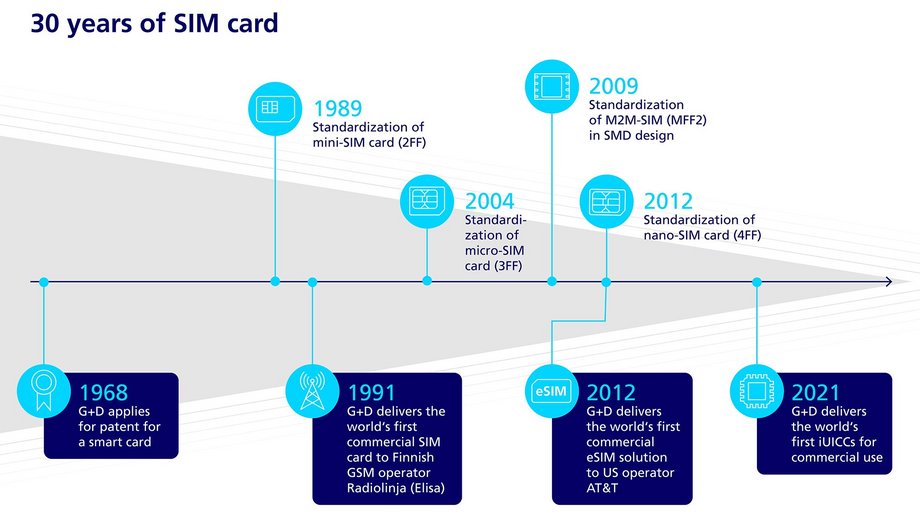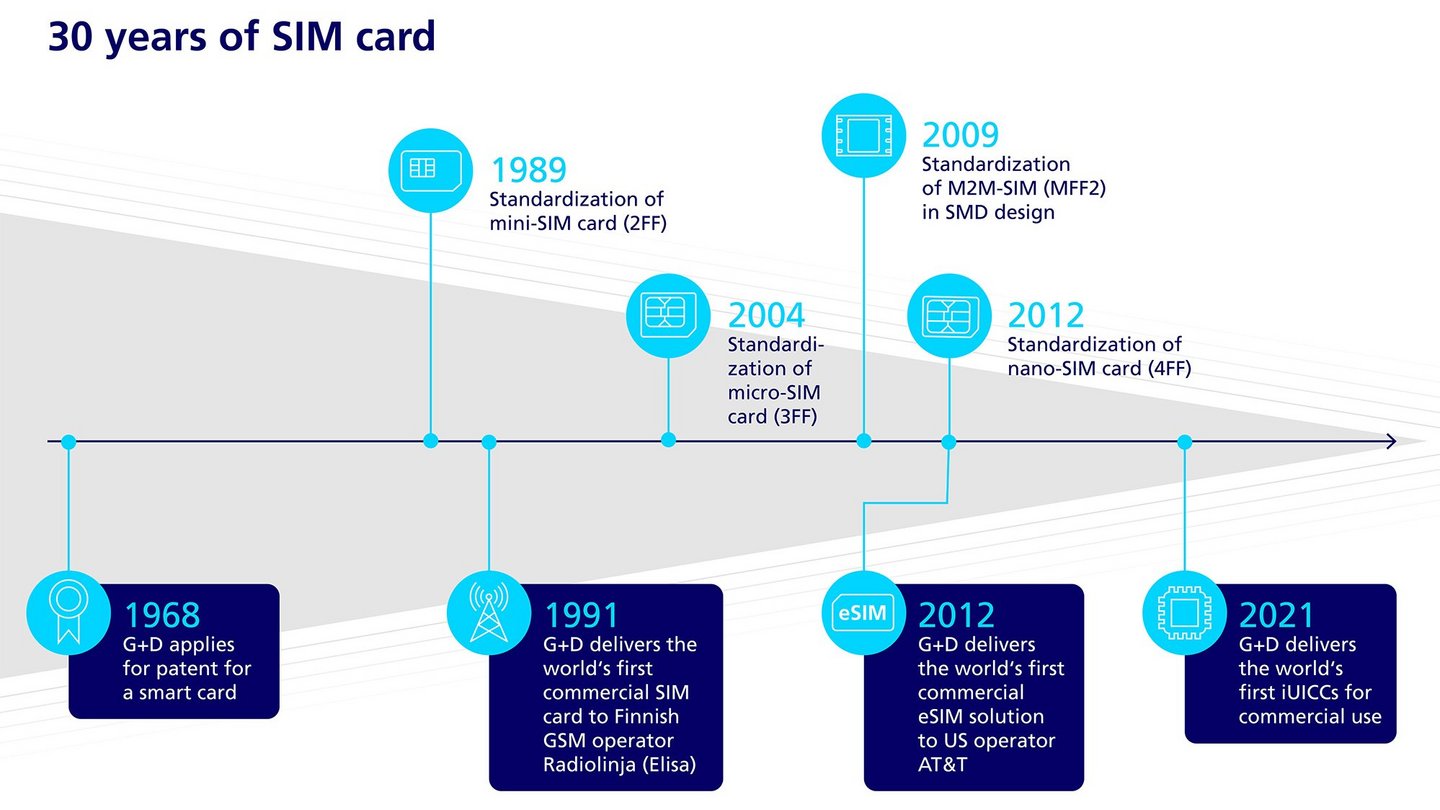Thirty years ago in Munich, Germany, G+D delivered the world’s first commercial SIM card to a telecommunications customer in Finland. Back then, few people could have anticipated the impact that this chip card would have on the world. As the SIM celebrates its 30th birthday, we speak to G+D’s Dr. Sandra Renner and Tobias Lepper, two people who have witnessed – firsthand – the SIM’s development over time. Together, we take a look at its evolution, and discuss what the SIM’s future may hold.

The SIM card turns 30!
As the world moves toward the eSIM, we take a look back at one of the most groundbreaking pieces of technology of the last 30 years – the humble SIM card – as it celebrates its 30th commercial birthday.
An evolution founded in security

That a company renowned for printing banknotes could create the SIM card, one of the world’s most innovative communication technologies, is at first glance unlikely. But Lepper, G+D Senior Product Marketing Manager, Domain Offering TCD, explains it this way: “We’re an innovative security company. We started in banknote printing over 160 years ago, and we evolved over time. The step from printing paper money to plastic money, in the shape of payment debit and credit cards, was natural, if indirect. In the 1970s, we developed the plastic card for Eurocheques in an ID1 format – the same format that credit cards are today – followed by the first payment cards. In the beginning, we produced authorization cards for the German analog mobile network and cards for public pay phones. The next step was a chip card for GSM networks – a smart card with much more security. Security has always been at the heart of what we do, the common denominator.”
The main purpose of the SIM card is to allow secure access to the mobile network. As a smart card, the SIM is a tamper-proof hardware device, which provides a very high level of security. G+D has its own cryptography team that constantly keeps the security up to date. The team has a state-of-the-art lab, so it can always stay ahead of the hackers and also to meet future requirements.
Dr. Klaus Vedder, a mathematician and longtime G+D employee, worked with his team to standardize the SIM card, and in 1989, unveiled the first plug-in SIM with one cut corner – just as we know it today.
“It connects the world, and it stores keys and data safely. And that hasn’t changed over the past 30 years. Of course, more use cases have evolved, and new features in the operating system of the SIM have been developed, but the core idea remains“
G+D Head of Customer Product Management TCD CENE/CIS
An innovative forerunner
“The SIM has always triggered new possibilities and new innovations,” enthuses Dr. Renner, G+D Head of Customer Product Management TCD CENE/CIS. Dr. Renner started at G+D in 1995 and played a part in the SIM’s global expansion. She was there when Chile decided to adopt GSM technology – the first country outside of Europe to do so. “When it started, it was just in Europe,” Dr. Renner says, “but then it conquered the world.”
The SIM’s long-term success was not a given though. Looking back, Dr. Renner smiles as she references the early days of SIMs with 4 KB of memory space. “At one of the first Mobile World Congresses I participated in, we programmed a simple Excel sheet and handed it out on a floppy disk to allow customers to calculate how many text messages can be stored and how many numbers can be stored. They were the only options – you had to deal with the memory space available.” Today, things are completely different, and Dr. Renner says this is down to ceaseless innovations.
The first breakthrough came with the introduction of the SIM Toolkit. This enabled applications, which triggered new opportunities and meant the 4 KB memory space wasn’t the be-all and end-all.
The move toward the eSIM
Over time, SIM card size decreased as phone size decreased, and the world is now moving away from traditional plastic SIM cards to the more eco-friendly eSIM. The eSIM offers several benefits, both for the consumer and the environment. Lepper explains, “It works just like a plug-in SIM, with the same security and functionality. But it provides a fully digital user journey. Today, you have to go to a store to receive your card – or buy it online – but both methods take time. The eSIM lets you use your contract within a couple of minutes, including the ID check (which is mandatory in certain countries). The entire process is digital, and for the end customer, it’s very convenient. Now, it’s even possible to sign an eSIM contract for a country you wish to travel to, meaning you have mobile connectivity as soon as the plane touches the ground.”

“We were also the first company to commercially launch eSIM management,” notes Lepper. G+D was the first company to do the legwork on standardization in response to the automobile industry’s demands. “Connected cars need a SIM card – and the right SIM card for the right market, because roaming is costly and in some markets it’s prohibited to roam for a long period of time,” he says. “Car manufacturers didn’t want to buy hundreds of local SIMs and plug in each one in local factories – that poses a logistical issue.” The answer was eSIM management: the installation of a SIM, which is then programmed with a downloadable data plan when the car is ready for the market.
And innovation continues. Within the framework of the internet of things, G+D is working on solutions. Dr. Renner references the speed at which IoT devices are being connected. “There are all of these new devices and applications where connectivity is important,” she says. SIM solutions are needed now more than ever, and the next SIM evolution is on the radar: so-called integrated SIMs, in which the SIM is not a dedicated hardware module anymore. Here, the SIM operating system is running in a tamper-resistant element within the IoT device’s baseband module.
Where would we be without the SIM?

Dr. Renner tells a story about two friends who agreed to meet in Paris to travel on holiday together, in times before everyone had mobile phones in their pockets. Inevitably, one friend arrived a day early, one a day late, and they ended up spending holidaying separately. A world without the SIM card, and all that it changed, is now unimaginable. We are connected all of the time.
“It connects the world, and it stores keys and data safely,” Dr. Renner summarizes. “ And that hasn’t changed over the past 30 years. It’s the tamper-proof core of the entire ecosystem. Of course it has changed and developed, but the core idea remains.”
Published: 16/11/2021
Share this article
Subscribe to our newsletter
Don’t miss out on the latest articles in G+D SPOTLIGHT: by subscribing to our newsletter, you’ll be kept up to date on latest trends, ideas, and technical innovations – straight to your inbox every month.




